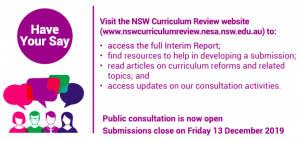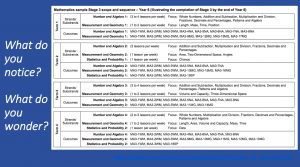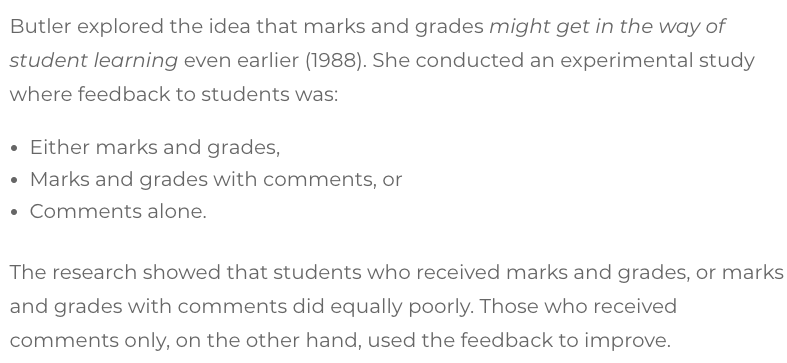Last week NESA (NSW Education Standards Authority) released the interim report on the curriculum review Nurturing wonder and igniting passion: Designs for a future school curriculum. This 131 page document presents a summary if initial feedback and early recommendations regarding the future of education in NSW.
“The Interim Report is informed by a first phase of public consultation on the NSW Curriculum Review, held between September and November 2018. Over 2,100 written submissions were received. The Interim Report also draws on educational research and lessons from other jurisdictions.”
NSW Curriculum Review, Interim Report Consultation Workbook, page 2
I submitted feedback last year as part of the consultation process so was keen to hear what others thought and where we may be headed as an education system. Overall it was encouraging to read about how the landscape of how teachers, educators, parents, community members, associations and the general public view education. There was a strong emphasis on the importance of skills that are sometimes beyond standard curriculum subjects – such as ways of thinking (design, inquiry, problem-solving, creative, critical) and creating a student-centred learning environment that makes connections through ‘big ideas’.
I highly recommend you read the full report for yourself and take the opportunity on offer to make further feedback on the proposed reforms suggested in the interim review. They have provided a workbook with questions for exploration. The workbook describes each reform direction, the objective stating ‘why’ it was suggested, and possible questions to discuss. If you are a teacher in a school, this would be best utilised in a small group to lead a discussion around each reform to then collect ideas and write a response.
In this blog I will only be commenting on the first two reform directions – Reforming the content of the curriculum, and, Reforming the structure of the curriculum. I have not commented on the third reform direction regarding the senior school curriculum, as my background is a primary school teacher. For each reform direction I probably have more wondering questions than ‘noticings’ or comments, you may find this too, with any suggestion there will always be: “yes, but how do we go about implementing that?” As classroom teachers we will be the ones actually putting into practice any or all of these ideas therefore being involved in this consultation is extremely important – both for us as teachers and for our students.
Reforming the content of the curriculum
The review suggests that the curriculum is currently overcrowded, I have previously written a blog about this idea and Jake Little @JakeLittle91 wrote a blog recently also challenging this idea. It is sometimes more about how the content itself is viewed or the lens through which you view the content that effects the amount of content present. The review states “The reduction of syllabus content should begin with the identification of what is essential to a subject”. My questions are, How do you determine what is ‘essential’ and what is not? Who will decide what needs to go? What content may be lost that is importance for students in one context that is not necessary for other students? I recall that in about 2009 a document was brought out titled “K-10 Mandatory Outcomes”, it had a dark blue cover – does anyone else remember this? I can’t locate my copy. But in essence, it was disbanded in the end as creating mandatory content left out important subject elements such as creative arts for example. Are we headed down this road again?
Do we really have an 'overcrowded' curriculum? I argue no- with 5 ideas to save time in maths. Blog inspired from this week's @NewsAtNESA NSW Curriculum Review- with (previous) ideas from @attard_c @kath_cartwright @MathsNSW https://t.co/yqrTWJCMQB
— Jake Little (@JakeLittle91) October 24, 2019
I do not necessarily believe our curriculum is overcrowded, but there is no doubt that the amount of content we have now, and the pressure teachers feel to ‘tick all the boxes’ does need reconsidering. So how can we reduce the curriculum without losing the integrity of each subject area? For me, I’d leave the curriculum content as-is. However, I believe teachers and school should have the right (and permission) to make decisions about which aspects and which outcomes to teach. As stated in our mathematics syllabus, these decisions should be made by teachers based on the “needs, interests and abilities of their students” (page 32) – if only this were actually the freedom and flexibility that teachers could feel. If we had the choice over the content it wouldn’t matter how much content there was, I can pick and choose what to focus on and when, as needed by my students.
There are some excellent suggestions within this reform direction including: students learning a language other than English, opportunities for students to transfer and apply knowledge, time to teach deeply, and revision of teacher work load.
Reforming the structure of the curriculum
The second reform relates to the way our curriculum is currently structured and suggests moving to reorganise the syllabuses into a sequence of attainment levels that focuses on students’ reaching year level expectations – providing flexibility in ‘when’ teachers teach ‘what’ and for how long. This is an interesting suggestion and I think flexibility is the key. In implementing this kind of reform it may be difficult to monitor and obtain consistency across the state regarding teachers’ justifying these decisions and how this may effect reporting to parents. It may also effect student participation, and assessment of knowledge and skills, within standardised testing (if these still exist!). Flexibility with timing of teaching is mentioned within this section and is one reform that wouldn’t take too many changes to current curriculum to implement. A greater respect for teachers’ professional judgement regarding when students are ready for learning new content and when consolidation is needed is welcomed.
In terms of timing, I am currently supporting a number of schools who are re-evaluating and redesigning their mathematics scope and sequence. One suggestion I often provide is to simply take the weeks (and number of lessons/ hours) off the document. This within itself provides at least a small amount of freedom for teachers to still be focusing on similar content (if that’s the school’s grade/stage structure) within a term but allows one teacher to possibly spend 3-4 weeks teaching content that another teacher may address is a week or two. All classrooms are technically multi-grade, removal of say the Stages as content organisers of our syllabus documents may be just as freeing.
Restructuring the curriculum: This reform direction within this section will be useful to discuss, particularly about ways these could be implemented and the potential problems that teachers may foresee. It is suggested that restructuring will support individual learners and their needs and assist with differentiation. This sounds good however what does individual programming for all students look like in a classroom? Having year-based outcomes (as we currently do) does still have space for differentiation, this comes from teachers’ pedagogical content knowledge and required ongoing professional development.
Setting high expectations: This reform direction suggests setting standards of attainment, bringing NSW in line with other states and the Australian Curriculum’s year-level achievement standards. Whether they are year-based or not, the idea of overarching statements about students’ main learning aims assists teachers in identifying the ‘big ideas’ that become goals or benchmarks for individual students. In NSW the Stage Statements do this, they are under-utilised and a greater focus on using them should be encouraged. I will be running two webinars later in the year that focus on making connections, using big ideas, and highlight the important role the state statements play.
Monitoring learning and ensuring continuity of learning: These two reform directions relate to the structure of the curriculum and I think will have the greatest impact but also require the most changes to current practice. Tracking students per se is not a new practice to many NSW teachers, particularly those involved in the State’s Action Plan where the National Learning progressions are used heavily for tracking and monitoring purposes. However, poorly implemented, tracking could mean just more data collection for teachers, “data for data’s sake”. It would also need to be made clear about what ‘on track’ means, many parents and carers may interpret this as a comparison of their child in relation to other students in their cohort. Communication about the achievement standards will be essential. It is good to see the impact of transition brought back into focus, stronger connections across pre-school, primary and secondary contexts, and funding to support transition programs are needed.
Assessing and communicating learning: The last direction aligns to research where student comments are often far superior and result in greater learning success than marks alone or marks and comments together. Reporting to students, parents and carers in relation to their own progress in relation to attainment standards will provide clearer directions for future learning. This direction is perhaps a hint towards the possible removal of A to E grading, a decision I believe, would result in a teachers’ ticker tape parade in the streets!
If you are interested in what others are saying about the curriculum review you can follow NESA on twitter via @CurriculumNESA, follow the hashtag #NSWCurriculumReview or check out a few of the posts below.
NSW state schools could undergo a curriculum shake-up that would reduce the number of subjects studied and emphasise "real world" skills, if the findings of a review are accepted. https://t.co/Fd3kHxcs1p
— 10 News First (@10NewsFirst) October 22, 2019
The interim curriculum review has proposed sweeping changes to the state's schools, including a renewed focus on maths, English and science. https://t.co/bu6F4wk2o0
— The Educator (@TheEducatorAU) October 22, 2019
Few will argue with the NSW Curriculum Review’s overarching finding that change is needed. Far too many Australian students lack confidence and competence in reading, writing and mathematics — especially in comparison with their peers in Europe and Asia.https://t.co/wbYn1K9nBr
— CIS (@CISOZ) October 25, 2019
Have your say by participating in this next phase of consultation. This is an opportunity to share your ideas, beliefs and thinking n order to reshape our curriculum structures, some of which have been behind current research and educational practices for a while. My hope is that there will also be some consistency across the state in political and policy decisions made regarding school curriculum. For example, the announcement of mandating mathematics in years 11 and 12 seems to go against what the review in essence was stating. We need to keep voicing our concerns and suggest appropriate ways forward. Saying “no, that won’t work” isn’t enough. Alternate pathways and ideas need to be brought forward to take our students, and our curriculum as a whole, into the future.
This article brings up a valid point. In light of the initial curriculum review report - why are we making mathematics mandatory? I see no benefit for Sts - making something mandatory will not increase students love or enjoyment of maths. There are other ways. https://t.co/pgJpkVroHq
— katherin cartwright (@kath_cartwright) October 26, 2019
References
Butler, R. (1988). Enhancing and undermining intrinsic motivation: The effects of task–involving and ego-involving evaluation on interest and performance. British Journal of Educational Psychology, 58: 1-14.








